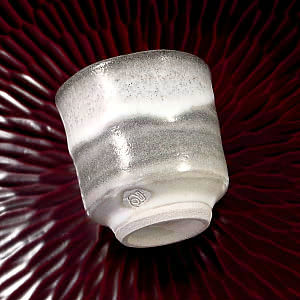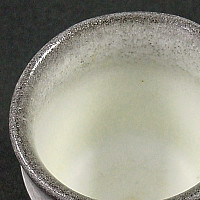|


Published by Yakimono.net February 2002
Scenic Delights for Sake Sipping
|
|
|
(L) Guinomi by Niwa Ryochi
(R) Tokkuri by Kato Kageaki (1899-1972)
|
|
The dark shadows and gray field landscapes, or keshiki, created by the glazes on these two pieces are an endless delight to gaze upon. They represent the magic in the potter's alchemist skills for creating ethereal landscapes on clay.
The glazes of the East are particularly mystical and unmatched anywhere in the world. When Rosanjin met Chagall on his European trip in 1954, Chagall told Rosanjin, "the clays, the glazes, when those secrets become known over here, our ceramics will be works of art too." I wonder what Chagall would have said if he saw these two works. He might have just simply let out an "ahhhhh" for there is a beauty that goes beyond the spoken tongue.

The above guinomi is from one of the finest sake producing prefectures in all of Japan -- Yamagata. I have never been there, yet one day I shall taste a dewa sansan sake in a local tavern, and also visit the studio of Niwa Ryochi. He's the maker of this subtle mountain-landscape guinomi. Niwa works in the Hira-Shimizu style, becoming the 4th master of the Seiryu-gama (kiln) in 1950; he entered the kiln at age fourteen in 1946.
 The inside of the guinomi is like a pure snowfield; light and airy, the mikomi* is almost a white beyond white -- something intensely pure (* mikomi means the "pool" inside the cup). The outside, with its smoky grays being overlapped by white creates a miniature handheld hanging scroll right out of the Muromachi period. The inside of the guinomi is like a pure snowfield; light and airy, the mikomi* is almost a white beyond white -- something intensely pure (* mikomi means the "pool" inside the cup). The outside, with its smoky grays being overlapped by white creates a miniature handheld hanging scroll right out of the Muromachi period.
The tsutsugata (cylindrical) shape isn't too thin but perfect in its weight and balance. It's a guinomi I never tire of and I can't wait to get to Yamagata; maybe after the February snow melt. A good thing is that I know the snowy scene in this guinomi will never melt.
If the guinomi is showing outdoor landscapes, the tall tokkuri speaks of inner places. The glaze dances over the elegant form, sometimes in a straight black cascade, often breaking to show rusty red patches. The mind harbors memories like that as well covering some over, leaving some partly exposed, and letting others just sink to the bottom where we sometimes find out who we are. In this case, there is a stamp on the bottom so we can discover the maker; it says Kageaki. That would be Kato Kageaki (1899-1972), a twelfth generation Mino master. His grandson is now the fourteenth generation, Kato Yasukage.
 Now if Chagall had seen this tokkuri I think he would have talked of the mystery of God; the western god in this sense. The tsubaki-de-like glaze (rusty reds and browns) hides emotions and memories that quite possibly only god might help one to understand. But then again in Japan, that god might be inside in a Zen Way. Now if Chagall had seen this tokkuri I think he would have talked of the mystery of God; the western god in this sense. The tsubaki-de-like glaze (rusty reds and browns) hides emotions and memories that quite possibly only god might help one to understand. But then again in Japan, that god might be inside in a Zen Way.
There is a 1919 Chagall painting called Musician with Violin and the feeling is one of darkness and pleasure like the temperament on this Kato piece.
I'm sure Chagall would have loved to have sat down one night after painting and sip some sake from these two scenic pieces.
|